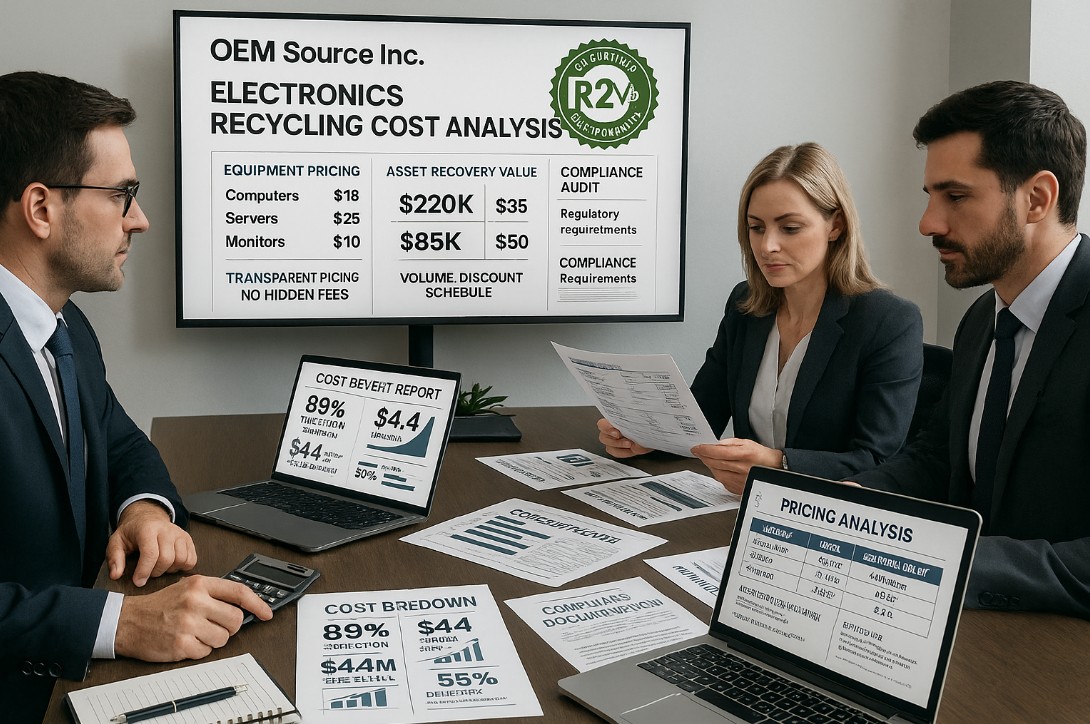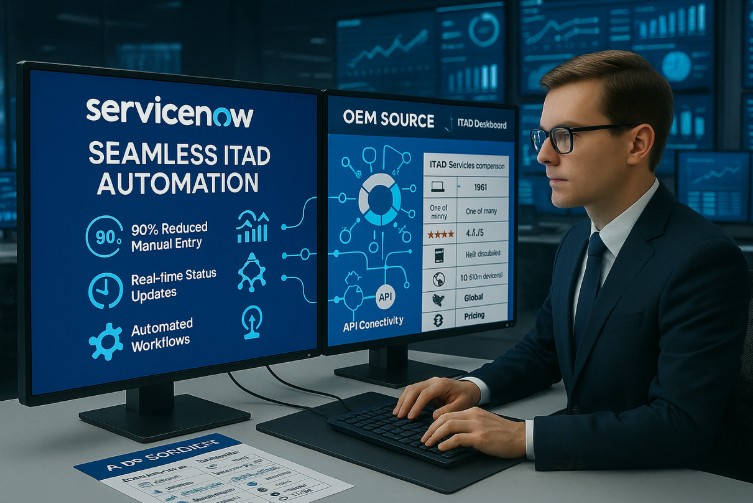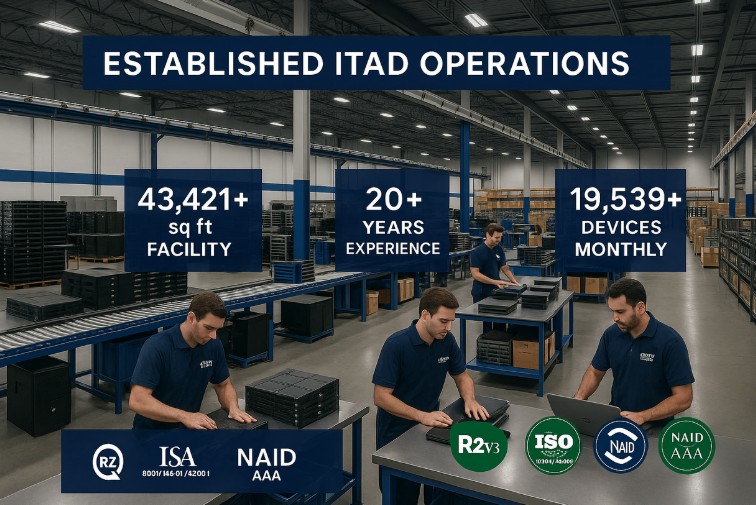Understanding R2v3 Certified Recycling Costs
Need transparent pricing for R2v3 certified electronics recycling? This guide breaks down real-world costs, pricing factors, and how to get the best value from certified recycling companies.
What R2v3 Certification Means for Pricing
Why R2v3 Certified Costs More
- Rigorous compliance requirements increase operational costs
- Enhanced tracking and documentation systems
- Specialized facilities and equipment investments
- Regular audits and certification maintenance
- Trained personnel with certification requirements
Value You Get for Premium Pricing
- Guaranteed compliance with environmental regulations
- Detailed documentation for audit and reporting
- Risk mitigation from regulatory violations
- Brand protection through responsible practices
- Stakeholder confidence in environmental stewardship
R2v3 Certified Recycling Pricing Breakdown
Typical Cost Ranges by Equipment Type
| Equipment Category | Cost Range | Notes |
|---|---|---|
| Desktop Computers | $8-15 per unit | Varies by age and condition |
| Laptops | $5-12 per unit | Higher recovery value offsets costs |
| Servers | $25-75 per unit | Size and complexity dependent |
| Network Equipment | $10-30 per unit | Recovery value often high |
| Monitors/Displays | $3-8 per unit | CRT monitors cost more |
| Printers | $5-20 per unit | Large format printers cost more |
| Mobile Devices | $2-5 per unit | Often have recovery value |
| Data Storage | $15-50 per unit | Destruction requirements increase cost |
Additional Service Costs
- Data destruction (NAID AAA): $25-100 per drive
- On-site pickup: $150-500 per trip
- Packaging and transportation: $0.50-2.00 per pound
- Certificate of recycling: $50-200 per project
- Detailed reporting: $100-500 per project
Factors That Affect R2v3 Pricing
Volume and Scale
- Small quantities (under 100 units): Premium per-unit pricing
- Medium volumes (100-1000 units): Standard market rates
- Large volumes (1000+ units): Volume discounts available
- Ongoing contracts: Best pricing with committed volumes
Geographic Location
- Urban areas: Lower transportation costs, more competition
- Rural locations: Higher pickup costs, limited options
- Regional variations: 15-25% cost differences between markets
- Distance from facility: Transportation costs increase with distance
Equipment Condition and Age
- Newer equipment (under 5 years): Often has recovery value
- Older equipment (5-10 years): Neutral to small disposal cost
- Legacy equipment (10+ years): Higher disposal costs
- Damaged equipment: Premium charges for special handling
Compliance Requirements
- Basic R2v3: Standard certified recycling rates
- Enhanced security: 20-40% premium for secure handling
- Industry-specific compliance: Additional costs for specialized requirements
- Audit documentation: Premium for detailed reporting and tracking
Asset Recovery vs. Disposal Costs
Equipment with Recovery Value
- Recent servers and networking equipment
- High-end workstations and laptops
- Specialized industrial equipment
- Precious metal-rich components
Typical Recovery Scenarios
- Break-even: Recovery value equals disposal costs
- Positive value: Recovery exceeds costs by 10-50%
- Premium recovery: High-value equipment generates significant revenue
- Cost offset: Recovery reduces net disposal costs
Factors Affecting Recovery Value
- Market demand for specific equipment types
- Condition and functionality of equipment
- Age and technology relevance
- Volume and consistency of equipment streams
How to Get Accurate R2v3 Pricing
Information to Provide for Quotes
- Equipment inventory with quantities and models
- Condition assessment (working, non-working, damaged)
- Location and accessibility for pickup
- Timeline requirements and flexibility
- Compliance needs and documentation requirements
Questions to Ask Providers
- What is your all-inclusive cost per unit or pound?
- How do you handle asset recovery and revenue sharing?
- What additional fees might apply (pickup, documentation, etc.)?
- Can you provide references from similar projects?
- What certifications do you maintain beyond R2v3?
Red Flags in Pricing
- Extremely low quotes that seem too good to be true
- Hidden fees not disclosed upfront
- Vague pricing without specific breakdowns
- No asset recovery discussion or evaluation
- Pressure tactics for immediate decisions
OEM Source R2v3 Certified Pricing Advantages
Transparent Pricing Structure
- All-inclusive quotes with no hidden fees
- Detailed breakdowns by equipment category
- Asset recovery evaluation is included in every quote
- Flexible payment terms, including net 30/60 options
Competitive Cost Advantages
- 20+ years of experience – driving operational efficiency
- Specialized equipment – reducing processing costs
- Strong recovery markets – maximizing asset values
- Efficient logistics – minimizing transportation costs
Value-Added Services Included
- R2v3 certification with full documentation
- NAID AAA data destruction when required
- Detailed reporting for compliance and audit
- Certificate of recycling with tracking numbers
- Customer portal access for project tracking
Cost Optimization Strategies
Timing Your Recycling Project
- Market conditions affect recovery values
- Seasonal factors influence transportation costs
- Budget cycles may offer better pricing
- Volume accumulation for better rates
Preparation to Reduce Costs
- Equipment consolidation for efficient pickup
- Basic data wiping before pickup (if appropriate)
- Accurate inventory for precise quotes
- Flexible scheduling to reduce premium charges
Long-term Cost Management
- Annual contracts for predictable pricing
- Regular recycling to maintain equipment value
- Vendor partnerships for consistent service
- Budget planning based on historical costs
Industry-Specific Pricing Considerations
Healthcare Organizations
- HIPAA compliance adds 15-25% to base costs
- Medical device disposal requires specialized handling
- Enhanced documentation for regulatory requirements
- Flexible scheduling around patient care operations
Financial Services
- Enhanced security requirements increase costs by 20-30%
- Regulatory compliance (SOX, PCI) adds documentation costs
- On-site destruction preferred, increasing service costs
- Detailed audit trails require premium reporting
Government Agencies
- Security clearance requirements add complexity and cost
- GSA contract pricing may offer standardized rates
- Enhanced documentation for transparency requirements
- Specialized handling for classified equipment
Educational Institutions
- Budget constraints require a cost optimization focus
- Seasonal scheduling may affect pricing
- FERPA compliance for student data protection
- Volume discounts for large institutional projects
Sample Pricing Scenarios
Small Office (50 computers, 20 monitors)
- Equipment disposal cost: $650-950
- Potential asset recovery: $200-600
- Net cost: $50-750
- Timeline: 1-2 weeks
Medium Enterprise (500 mixed units)
- Equipment disposal cost: $3,500-6,500
- Potential asset recovery: $1,500-4,000
- Net cost: $0-5,000 (often break-even or positive)
- Timeline: 2-4 weeks
Large Data Center (2,000+ units)
- Equipment disposal cost: $15,000-35,000
- Potential asset recovery: $8,000-25,000
- Net cost: $0-27,000 (frequently generates revenue)
- Timeline: 4-8 weeks
Getting the Best R2v3 Certified Value
Evaluation Criteria Beyond Price
- Certification verification and audit history
- Customer references and project success stories
- Service quality and responsiveness
- Compliance capabilities for your industry
- Asset recovery expertise and market connections
Making the Final Decision
- Total cost of ownership, including all fees
- Risk mitigation value of proper compliance
- Service quality and communication
- Long-term partnership potential
- Recovery value optimization
Ready to Get Your R2v3 Certified Quote?
Don’t let compliance requirements drain your budget. The right R2v3 certified partner will provide transparent pricing, maximize asset recovery, and ensure complete regulatory compliance.
OEM Source delivers industry-leading R2v3 certified recycling with transparent pricing, superior asset recovery, and comprehensive compliance documentation.
Get your detailed R2v3 certified recycling quote today and discover how specialized expertise and transparent pricing can optimize your electronics disposal budget while ensuring complete environmental compliance.





